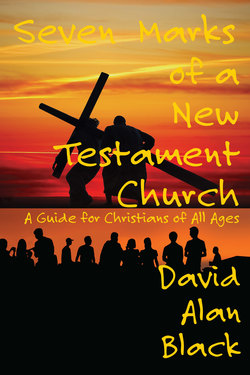Читать книгу Seven Marks of a New Testament Church: - David Alan Black - Страница 6
На сайте Литреса книга снята с продажи.
ОглавлениеIntroduction
For years I have wanted to write a book on ecclesiology. This book, however, is not it. Instead, I have tried to ask the New Testament a very simple question: “What does a healthy, biblical church look like?” Of course, many excellent writers have attempted to answer this question. Books about the church are more abundant than ever. I do not claim to have found the only answer to this question. The one thing I have tried to do is allow the Scriptures to speak for themselves. You will notice that I asked my question of the New Testament itself; and it seems to me that the New Testament has provided us with an extraordinarily clear answer. The more I ponder the book of Acts, the more convinced I am that the wonderful chapter describing the birth of the church makes a fitting starting point for the study of New Testament ecclesiology. Should we ask, “Where do we start?”, our course is already plotted, in eleven brief verses no less. I am speaking of Acts 2:37-47, verses that describe at least seven basic characteristics of the newly-formed church in Jerusalem. Hence the title: Seven Marks of a New Testament Church. Here is my translation of these verses:
Now when they heard this, they were cut to the heart and said to Peter and the other apostles, “Brothers, what should we do?” Peter said to them, “Repent, and be baptized every one of you in the name of Jesus Christ so that your sins may be forgiven, and you will receive the Holy Spirit as a gift. For the promise is for you, for your children, and for all who are far away, everyone whom the Lord our God calls to Him.” And he testified with many other arguments and exhorted them, saying, “Be saved from this corrupt generation!” So those who welcomed his message were baptized, and that day about three thousand people were added to the group.
They devoted themselves to the apostles’ teaching, to the fellowship, to the breaking of the bread, and to the prayers. A deep sense of awe came over them all, and the apostles performed many miraculous signs and wonders. All the believers continued together in close fellowship and shared everything they had with one another. They would sell their property and possessions and distribute the money among all, according to what each person needed. Day after day they worshiped together in the temple and had meals together in their homes, eating with glad and humble hearts, all the while praising God and enjoying the goodwill of all the people. And every day the Lord kept adding to their group those who were being saved.
Before we examine this passage in greater detail, permit me to make four brief but important observations.
First, you will notice that I did not entitle my book “The Seven Marks of a New Testament Church.” No human can claim such certainty. That would be to have omniscience. We may, of course, assert that we have discovered “the” marks of the church, but the definite article betrays not certainty but arrogance. In the second place, these seven descriptions of a New Testament church are valid regardless of one’s denominational affiliation. After all, in the first century there were no Baptists or Presbyterians or Methodists or Catholics per se. These marks, I should think, would apply no less to modern mega-churches as to the joyous house churches of the first century. In the third place, it needs to be noted that the church in Acts 2 was hardly perfect. Remember, it was not the Jerusalem church that initiated the evangelism of Samaria or Antioch. That torch had to be passed to others. Even Peter did not yet fully understand the place the Gentiles would have in the church. Still, the church in Acts 2 exhibited all the vital signs of new life in Christ. A church can be exemplary and not be perfect. The key is that it must be moving in the right direction. Finally, we will study these marks in the order in which the text presents them to us. The reader will, no doubt, appreciate the logical and natural progression.
I am rather reluctant to add to the number of books on Acts. But I do want to awaken Christians to what these early followers of Jesus achieved. Their story is a remarkable one, and we would do well to emulate it. There is nothing new or profound in what I have written here. This is a simple book that any Christian can follow, even the newest believer. Quotations from the New Testament are my own translations made from the original Greek. In case you’re wondering, the seven characteristics we’ll be discussing are:
Evangelistic preaching
Christian baptism
Apostolic teaching
Genuine relationships
Christ-centered gatherings
Fervent prayer
Sacrificial living
All over the globe there is a beautiful but powerful grassroots movement in the church asking the question, “What does a healthy congregation look like?” Many are looking for a simple, biblical definition of “church.” Perhaps The First Church of Jerusalem can provide us with some answers. I hope so!
